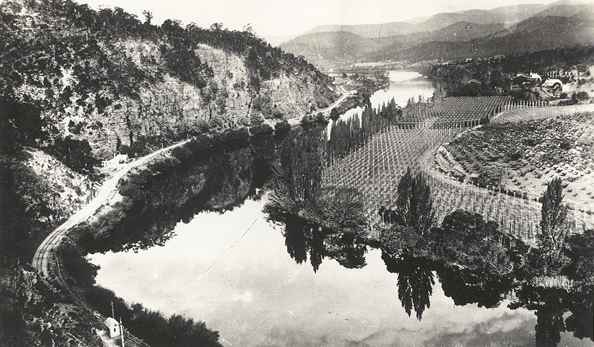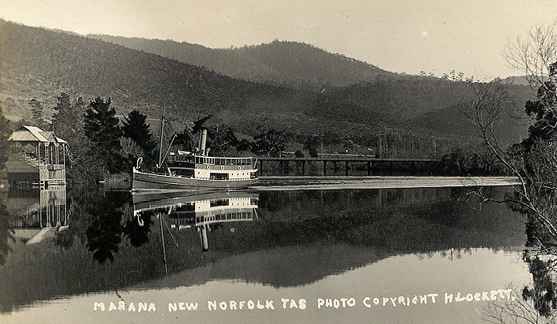 |

|
 |
|
History of New Norfolk 1807 - 1900 New Norfolk circa 1834 - the building on the right is the Bush Inn |
|
New Norfolk was the third planned settlement to be undertaken in Tasmania, after Hobart and Launceston. In 1803-4 when Hobart was first settled on the banks of the Derwent, it was considered important to explore this waterway and find out the potential of the surrounding areas. By 1807 the European population on the Derwent was "483 starving persons". The food supplies were so low that convicts were being sent out into the bush to kill kangaroos for meat issues from the stores. Starting in November 1807 and on through the following year, people from the Norfolk Island penal colony were persuaded to come to Van Diemenís Land by offers of a generous exchange of land (4 acres for each acre held on Norfolk Island), a house of similar standard to that left behind, 2 or 4 convicts to assist them in clearing their new farms, and food and clothing from the stores for 12 months. By late 1808, 544 people (soldiers, convicts and free settlers) had arrived and they put an enormous strain on the colony's fragile economy. However they did form a basis for the settlement of the district and provided many skills and profession that were lacking including 2 bakers, 2 blacksmiths, 4 bullock drivers, a butcher, 13 ex-constables, 2 gardeners, a harness maker, a milkman, a stonemason, 8 overseers, a painter & glazier, 2 saltboilers, 2 sawyers, a cooper and 2 carpenters. Although they were promised compensation for their forced move, many had the sense to realise that it would be impossible for the government ever to fulfil the wildly optimistic promises held out to them and some offered to supply themselves with housing if they could be provided with nails and a few necessary tools. Others proposed to wave all their claims for housing in exchange for stock (bengal cows and sheep) equal in value to the houses they had left behind on Norfolk. Of the new settlers, 24% were located to Sandy Bay, 19% to New Town and Glenorchy, 27% to the eastern shore between Bridgewater and Pittwater and the Clarence Plains area. The remaining 30% came to New Norfolk. New Norfolk was at first known as "The Hills" because of its setting among hills, valleys and gentle streams. In 1811 Governor Macquarie came to visit Van Diemenís Land. He mapped out a town site and named the town "Elizabeth Town" (after his wife) in the District of New Norfolk. The name did not catch on although it was used on and off from 1811 to 1825, but the local settlers, wanting to preserve a link with their old island home, won the day and the town was officially known as "New" Norfolk. The stream called the Thames by the locals, was renamed the "Lachlan" (pronounced Locklon) by Governor Macquarie (in honour of his son). However, although it retains the name to this very day, it is pronounced as "Lacklan" by the locals, much to the confusion of newcomers. Governor Macquarie ordered the Surveyor to plan and mark out the township and details of grants and leases. Hobart Town Authority was instructed to afford every encouragement and facility to industrious tradesmen and useful mechanics to reside and settle as soon as the new township had been sub-divided into regular allotments. The going was tough for the early settlers and most had to be supported on government rations until 1812. There were no roads and no transport as we know it and the population was entirely dependent on river transport or following dirt tracks overland using horse-drawn vehicles and bullock wagons. But the settlement slowly grew and prospered. |
 New Norfolk from the other side of the Derwent circa 1834 |
| In 1846 the first hop plants were brought in from Maria Island and this became a flourishing industry resulting in the traditional "New Norfolk" landscape - oast houses, fields of wired poles and windbreaks of Lombardy Poplars, a spectacular sight in autumn. |

|
| The Derwent Valley was rich in soil and timber and by 1902, had began to develop at a rapid pace. One of the contributing factors was the extension of the railway line. This much needed facility brought greater prosperity to the rural communities and in 1907 the Hydro-Electric Power & Metallurgical Company commenced operations at the Great Lake. Hobart was first illuminated by the Hobart Gas Company on 1 January, 1913 but three years later changed over to electricity from the Great Lakes Works. In 1915 the Hydro Electric Deptartment was requested by the Minister for Lands and Works to report on the possibility of an electricity supply for New Norfolk. |

|
| River steamers were an essential part of New Norfolkís development, among them the SS Marana, which ended its days as a fishing trawler at Victoria; the Maweena which eventually burnt; the Emu, which sank later near the New Norfolk bridge and is still there; and the Monarch which sank at the Lime Kilns. Flooding in the lower reaches of the Derwent River has been a periodic event and New Norfolk has rebuilt the bridge, linking both sides of the town, four times. The existence of Meadowbank Dam should remedy this situation. |

|
| The historic problems of wars and pestilence took their toll here too. Men served in the Boer War which began in October 1899 and ended in May 1902 and then the First and Second World Wars. Floods and the Pneumonic Flu in 1917 decimated the population of the island as it did across the world. |
or write to us at: PO Box 640, New Norfolk, TAS, 7140 If you have accommodation in New Norfolk or the surrounding areas (Lachlan, Lawitta, Magra, etc) and we have not listed your information on this site, please contact us immediately so we can add you to our database. If you do not have your own site for us to link to, we will make a one page "on-line brochure" on our newnorfolk.org server for you. If you do not have current photos, we are happy to visit you with our digital camera. We get many enquiries for accommodation in New Norfolk and the surrounding areas, so it is important that our list is as complete and accurate as possible, as soon as possible. We also welcome links for accommodation, restaurants and other attractions on the River's Run touring route, as are any attractions within an hours drive of New Norfolk. |
|
Back to Previous Page New Norfolk Main Page |